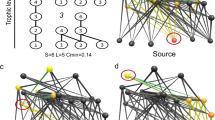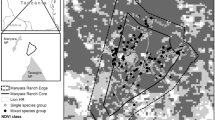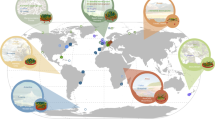Abstract
In nature, entangled webs of predator–prey interactions constitute the backbones of ecosystems. Uncovering the network architecture of such trophic interactions has been recognized as the essential step for exploring species with great impacts on ecosystem-level phenomena and functions. However, it has remained a major challenge to reveal how species-rich networks of predator–prey interactions are continually reshaped through time in the wild. Here, we show that dynamics of species-rich predator–prey interactions can be characterized by remarkable network structural changes and alternations of species with greatest impacts on community processes. On the basis of high-throughput detection of prey DNA from 1,556 spider individuals collected in a grassland ecosystem, we reconstructed dynamics of interaction networks involving, in total, 50 spider species and 974 prey species and strains through 8 months. The networks were compartmentalized into modules (groups) of closely interacting predators and prey in each month. Those modules differed in detritus/grazing food chain properties, forming complex fission–fusion dynamics of belowground and aboveground energy channels across the seasons. The substantial shifts of network structure entailed alternations of spider species located at the core positions within the entangled webs of interactions. These results indicate that knowledge of dynamically shifting food webs is crucial for understanding temporally varying roles of ‘core species’ in ecosystem processes.
This is a preview of subscription content, access via your institution
Access options
Access Nature and 54 other Nature Portfolio journals
Get Nature+, our best-value online-access subscription
$29.99 / 30 days
cancel any time
Subscribe to this journal
Receive 12 digital issues and online access to articles
$119.00 per year
only $9.92 per issue
Buy this article
- Purchase on Springer Link
- Instant access to full article PDF
Prices may be subject to local taxes which are calculated during checkout






Similar content being viewed by others
Data availability
The DNA sequencing data are available from the DNA Data Bank of Japan with the BioProject accession number PRJDB12701 and the sequence read archive numbers DRA016403-DRA016405. The community data are deposited at our GitHub repository (https://github.com/hiro-toju/spider_prey_1).
Code availability
All the scripts used to analyse the data are available at the GitHub repository (https://github.com/hiro-toju/spider_prey_1).
References
Link, J. Does food web theory work for marine ecosystems? Mar. Ecol. Prog. Ser. 230, 1–9 (2002).
Thompson, R. M. et al. Food webs: reconciling the structure and function of biodiversity. Trends Ecol. Evol. 27, 689–697 (2012).
Nakano, S. & Murakami, M. Reciprocal subsidies: dynamic interdependence between terrestrial and aquatic food webs. Proc. Natl Acad. Sci. USA 98, 166–170 (2001).
Hendrix, P. F. et al. Detritus food webs in conventional and no-tillage agroecosystems. Bioscience 36, 374–380 (1986).
Paine, R. Food webs: linkage, interaction strength and community infrastructure. J. Anim. Ecol. 49, 666–685 (1980).
Polis, G. A. Complex trophic interactions in deserts: an empirical critique of food-web theory. Am. Nat. 138, 123–155 (1991).
Moore, J. C., Walter, D. E. & Hunt, H. W. Arthropod regulation of micro- and mesobiota in below-ground detrital food webs. Annu. Rev. Entomol. 33, 419–435 (1988).
Power, M. E. Effects of fish in river food webs. Science 250, 811–814 (1990).
Paine, R. T. Food web complexity and species diversity. Am. Nat. 100, 65–75 (1966).
Power, M. E. et al. Challenges in the quest for keystones. Bioscience 46, 609–620 (1996).
Rooney, N., McCann, K., Gellner, G. & Moore, J. C. Structural asymmetry and the stability of diverse food webs. Nature 442, 265–269 (2006).
Girvan, M. & Newman, M. E. J. Community structure in social and biological networks. Proc. Natl Acad. Sci. USA 99, 7821–7826 (2002).
Polis, G. A. & Strong, D. R. Food web complexity and community dynamics. Am. Nat. 147, 813–846 (1996).
Stouffer, D. B. & Bascompte, J. Compartmentalization increases food-web persistence. Proc. Natl Acad. Sci. USA 108, 3648–3652 (2011).
Toju, H. et al. Species-rich networks and eco-evolutionary synthesis at the metacommunity level. Nat. Ecol. Evol. 1, 0024 (2017).
Hooper, D. U. et al. Effects of biodiversity onecosystem functioning: a consensus of current knowledge. Ecol. Monogr. 75, 3–35 (2005).
Ushio, M. et al. Fluctuating interaction network and time-varying stability of a natural fish community. Nature 554, 360–363 (2018).
Poisot, T., Stouffer, D. B. & Gravel, D. Beyond species: why ecological interaction networks vary through space and time. Oikos 124, 243–251 (2015).
McMeans, B. C., McCann, K. S., Humphries, M., Rooney, N. & Fisk, A. T. Food web structure in temporally-forced ecosystems. Trends Ecol. Evol. 30, 662–672 (2015).
Bartley, T. J. et al. Food web rewiring in a changing world. Nat. Ecol. Evol. 3, 345–354 (2019).
CaraDonna, P. J. et al. Interaction rewiring and the rapid turnover of plant–pollinator networks. Ecol. Lett. 20, 385–394 (2017).
Poisot, T. et al. The dissimilarity of species interaction networks. Ecol. Lett. 15, 1353–1361 (2012).
Kondoh, M. Foraging adaptation and the relationship between food-web complexity and stability. Science 299, 1388–1391 (2003).
Olivier, P. et al. Exploring the temporal variability of a food web using long-term biomonitoring data. Ecography 42, 2107–2121 (2019).
Winemiller, K. O. Spatial and temporal variation in tropical fish trophic networks. Ecol. Monogr. 60, 331–367 (1990).
Toju, H. & Baba, Y. G. DNA metabarcoding of spiders, insects, and springtails for exploring potential linkage between above- and below-ground food webs. Zool. Lett. 4, 4 (2018).
Wardle, D. A. et al. Ecological linkages between aboveground and belowground biota. Science 304, 1629–1633 (2004).
Miyashita, T., Takada, M. & Shimazaki, A. Experimental evidence that aboveground predators are sustained by underground detritivores. Oikos 103, 31–36 (2003).
Allesina, S. & Pascual, M. Network structure, predator–prey modules, and stability in large food webs. Theor. Ecol. 1, 55–64 (2008).
Chen, B. & Wise, D. H. Bottom-up limitation of predaceous arthropods in a detritus-based terrestrial food web. Ecology 80, 761–772 (1999).
Blüthgen, N. N., Menzel, F. & Blüthgen, N. N. Measuring specialization in species interaction networks. BMC Ecol. 6, 9 (2006).
Bascompte, J., Jordano, P., Melia, C. J. & Olesen, J. M. The nested assembly of plant-animal mutualistic networks. Proc. Natl Acad. Sci. USA 100, 9383–9387 (2003).
Almeida-Neto, M., Guimarães, P. R.Jr & Lewinsohn, T. M. On nestedness analyses: rethinking matrix temperature and anti-nestedness. Oikos 116, 716–722 (2007).
Toju, H. et al. Below-ground plant–fungus network topology is not congruent with above-ground plant–animal network topology. Sci. Adv. 1, e1500291 (2015).
Barber, M. J. Modularity and community detection in bipartite networks. Phys. Rev. E 76, 066102 (2007).
Freeman, L. C. A set of measures of centrality based on betweenness. Sociometry 40, 35–41 (1977).
Olesen, J. M., Bascompte, J., Dupont, Y. L. & Jordano, P. The modularity of pollination networks. Proc. Natl Acad. Sci. USA 104, 19891–19896 (2007).
Guimerà, R. & Amaral, L. A. N. Functional cartography of complex metabolic networks. Nature 433, 895–900 (2005).
Volterra, V. Variations and fluctuations of the number of individuals in animal species living together. ICES J. Mar. Sci. 3, 3–51 (1928).
Elton, C. Animal Ecology (Univ. Chicago Press, 1927).
Polis, G. A. & Hurd, S. D. Extraordinarily high spider densities on islands: flow of energy from the marine to terrestrial food webs and the absence of predation. Proc. Natl Acad. Sci. USA 92, 4382–4386 (1995).
Sato, T. et al. Nematomorph parasites drive energy flow through a riparian ecosystem. Ecology 92, 201–207 (2011).
Hairston, N. G., Smith, F. E. & Slobodkin, L. B. Community structure, population control, and competition. Am. Nat. 94, 421–425 (1960).
van der Heijden, M. G. A., Martin, F. M., Selosse, M.-A. & Sanders, I. R. Mycorrhizal ecology and evolution: the past, the present, and the future. New Phytol. 205, 1406–1423 (2015).
Bardgett, R. D. & van der Putten, W. H. Belowground biodiversity and ecosystem functioning. Nature 515, 505–511 (2014).
Ings, T. C. et al. Ecological networks—beyond food webs. J. Anim. Ecol. 78, 253–269 (2009).
Nyffeler, M. & Birkhofer, K. An estimated 400–800 million tons of prey are annually killed by the global spider community. Sci. Nat. 104, 30 (2017).
Pilosof, S., Porter, M. A., Pascual, M. & Kéfi, S. The multilayer nature of ecological networks. Nat. Ecol. Evol. 1, 0101 (2017).
Toju, H. High-throughput DNA barcoding for ecological network studies. Pop. Ecol. 57, 37–51 (2015).
Chen, J. M. et al. Observation of antennal sensilla in Xylotrechus grayii (Coleoptera: Cerambycidae) with scanning electron microscopy. Microsc. Res. Tech. 77, 264–273 (2014).
Zhang, Y. R., Qiao, H. L., Ren, L. L., Wang, R. & Lu, P. F. Sample preparation method of scanning and transmission electron microscope for the appendages of woodboring beetle. J. Vis. Exp. 2020, e59251 (2020).
Kobayashi, T., Takada, M., Takagi, S., Yoshioka, A. & Washitani, I. Spider predation on a mirid pest in Japanese rice fields. Basic Appl. Ecol. 12, 532–539 (2011).
Sint, D., Raso, L., Kaufmann, R. & Traugott, M. Optimizing methods for PCR-based analysis of predation. Mol. Ecol. Resour. 11, 795–801 (2011).
Macías-Hernández, N. et al. Molecular gut content analysis of different spider body parts. PLoS ONE 13, e0196589 (2018).
Marquina, D., Andersson, A. F. & Ronquist, F. New mitochondrial primers for metabarcoding of insects, designed and evaluated using in silico methods. Mol. Ecol. Resour. 19, 90–104 (2019).
Clarke, L. J., Soubrier, J., Weyrich, L. S. & Cooper, A. Environmental metabarcodes for insects: in silico PCR reveals potential for taxonomic bias. Mol. Ecol. Resour. 14, 1160–1170 (2014).
Lundberg, D. S., Yourstone, S., Mieczkowski, P., Jones, C. D. & Dangl, J. L. Practical innovations for high-throughput amplicon sequencing. Nat. Methods 10, 999–1002 (2013).
Stevens, J. L., Jackson, R. L. & Olson, J. B. Slowing PCR ramp speed reduces chimera formation from environmental samples. J. Microbiol. Methods 93, 203–205 (2013).
Hamady, M., Walker, J. J., Harris, J. K., Gold, N. J. & Knight, R. Error-correcting barcoded primers for pyrosequencing hundreds of samples in multiplex. Nat. Methods 5, 235–237 (2008).
Toju, H., Kurokawa, H. & Kenta, T. Factors influencing leaf- and root-associated communities of bacteria and fungi across 33 plant orders in a grassland. Front. Microbiol. 10, 241 (2019).
Tanabe, A. Claident v0.2.2018.05.29 (2018); http://www.fifthdimension.jp/
Edgar, R. C., Haas, B. J., Clemente, J. C., Quince, C. & Knight, R. UCHIME improves sensitivity and speed of chimera detection. Bioinformatics 27, 2194–2200 (2011).
Rognes, T., Flouri, T., Nichols, B., Quince, C. & Mahé, F. VSEARCH: a versatile open source tool for metagenomics. PeerJ 4, e2584 (2016).
Tanabe, A. S. & Toju, H. Two new computational methods for universal DNA barcoding: a benchmark using barcode sequences of bacteria, archaea, animals, fungi, and land plants. PLoS ONE 8, e76910 (2013).
Huson, D. H., Auch, A. F., Qi, J. & Schuster, S. C. MEGAN analysis of metagenomic data. Genome Res. 17, 377–386 (2007).
Arribas, P. et al. Toward global integration of biodiversity big data: a harmonized metabarcode data generation module for terrestrial arthropods. Gigascience 11, giac065 (2022).
Andújar, C. et al. Validated removal of nuclear pseudogenes and sequencing artefacts from mitochondrial metabarcode data. Mol. Ecol. Resour. 21, 1772–1787 (2021).
Alberts, B. et al. Molecular Biology of the Cell 4th edn (Garland Science, 2002).
Anderson, M. J. A new method for non-parametric multivariate analysis of variance. Austral. Ecol. 26, 32–46 (2001).
Oksanen, J. vegan: Community Ecology Package. R version 2.6-2 https://cran.r-project.org/web/packages/vegan/index.html (2007).
Dormann, C. F., Gruber, B. & Fruend, J. Introducing the bipartite package: analysing ecological networks. R News https://www.biom.uni-freiburg.de/Dateien/PDF/dormann2008rnews.pdf (2018).
Blondel, V. D., Guillaume, J. L., Lambiotte, R. & Lefebvre, E. Fast unfolding of communities in large networks. J. Stat. Mech. Theory Exp. 2008, P10008 (2008).
Clauset, A., Newman, M. E. J. & Moore, C. Finding community structure in very large networks. Phys. Rev. E 70, 066111 (2004).
Rosvall, M. & Bergstrom, C. T. Maps of random walks on complex networks reveal community structure. Proc. Natl Acad. Sci. USA 105, 1118–1123 (2008).
Csardi, G. & Nepusz, T. The igraph software package for complex network research. InterJ. Complex Syst. 1695, 1–9 (2006).
Brunson, J. ggalluvial: layered grammar for alluvial plots. J. Open Source Softw. https://doi.org/10.21105/joss.02017 (2020).
Acknowledgements
We thank H. Fujita for his advice on statistical analyses. This work was financially supported by JSPS Grant-in-Aid for Scientific Research (18H04009) and JST FOREST (JPMJFR2048) to H.T.
Author information
Authors and Affiliations
Contributions
H.T. designed the work with S.S.S. S.S.S. performed experiments. S.S.S. analysed the data with H.T. S.S.S. and H.T. wrote the paper with Y.G.B.
Corresponding authors
Ethics declarations
Competing interests
The authors declare no competing interests.
Peer review
Peer review information
Nature Ecology & Evolution thanks Miguel Lurgi and Henrik Krehenwinkel for their contribution to the peer review of this work. Peer reviewer reports are available.
Additional information
Publisher’s note Springer Nature remains neutral with regard to jurisdictional claims in published maps and institutional affiliations.
Extended data
Extended Data Fig. 1 Overview of the spider and prey compositions.
a, Rarefaction curves of the prey data. Relationship between the number of sequencing reads and that of detected Hexapoda OTUs is shown for each sample. b, Composition of collected spider species. The numbers of the collected spider specimens are shown for each month. c, Genus-level taxonomy of detected prey. The compositions of prey detection counts are shown across the sampling months in terms of the genus-level taxonomy. d, Order-level taxonomy of detected prey. The compositions of prey detection counts are shown across the sampling months in terms of the order-level taxonomy. e, Effects of spider species and sampling months on prey compositions. A PERMANOVA of family-level prey compositions (Fig. 1b) was performed by setting spider species, sampling months, and interactions between them as explanatory variables.
Extended Data Fig. 2 Counts of prey detection from respective spider species.
The compositions of prey detection counts are shown for each spider species across the sampling months. Top 19 spider species with highest numbers of specimens with prey sequences are presented.
Extended Data Fig. 3 Hunting type of spiders.
For each category (hunting type) of spiders (as defined in Fig. 3), the compositions of prey detection counts are shown with putative ecological guilds of prey. Based on family-level taxonomy, the prey guilds were classified into four categories: herbivores, predators/parasites, detritivores, and omnivores (variable feeding habits). The prey OTUs unidentified at the family level were omitted in the graphs.
Extended Data Fig. 4 Network topology.
Within the networks depicting the predator–prey interactions observed in respective months, the family-level taxonomy of prey vertices is indicated. The layout of the vertices was optimized based on the ‘stress’ algorithm of network ordination as implemented in the ggraph package of R.
Extended Data Fig. 5 Network modules.
Within each network depicting predator–prey interactions, vertices were classified into modules consisting of closely interacting spiders and prey based on the ‘Louvain’ algorithm.
Extended Data Fig. 6 Temporal variability in topological roles.
For the three spider species collected throughout the seasons (spider species that appeared in seven or eight months), temporal shifts of interaction generality and betweenness network centrality are presented. The size of symbols is roughly proportional to the number of spider individuals analysed. Colour indicates sampling months.
Extended Data Fig. 7 Original and bootstrap-standardized values of among-module connectivity.
For respective species within the meta-network representing all the interactions observed through the eight months (Fig. 5), the original and bootstrap-standardized values of among-module connectivity are shown on the horizontal and vertical axes, respectively. In the bootstrap analysis, the prey repertoire of each spider individual was bootstrap-sampled from the sample-level matrix in each month, subsequently converted into species-level matrices (1,000 interations). The bootstrapped species-level matrices of the eight months were then integrated as bootstrapped meta-network matrices for comparison with the original meta-network structure. Note that bootstrap-standardized values were unavailable for network vertices whose among-module connectivity were consistently zero across the bootstrapping.
Extended Data Fig. 8 Statistical significance in the bootstrapping analysis of among-module connectivity.
he relationship between bootstrap-standardized among-module connectivity (Fig. 6) and false discovery rate (FDR; one-tailed test) is shown.
Extended Data Fig. 9 Comparison of algorithms for modularity estimation.
For the estimation of modularity, three module-finding algorithms, namely, the ‘Louvain’, ‘fast greedy’, and ‘Infomap’ algorithms, were compared. Higher modularity scores represent more optimized module memberships. Based on the inferred memberships (Extended Data Fig. 5), Newman’s and Barber’s metrics of modularity were respectively calculated. a, Newman’s standard metric of modularity. b, Barber’s metric of modularity for bipartite networks.
Extended Data Fig. 10 Standardization of betweenness centrality based on bootstrapping.
To examine whether each species play disproportionately important topological roles as network cores (hubs) relative to its abundance, bootstrap-standardized betweenness index was calculated for each network node (spider species or prey OTU) in each month. Specifically, the prey repertoire of each spider individual was bootstrap-sampled from the sample-level matrix in each month (1,000 interations). The bootstrapped sample-level matrices were then converted into species-level matrices, subjected to the calculation of betweenness centrality. Bootstrap-standardized betweenness scores were then obtained as \(\frac{{X}_{{observed}}-{Mean}({X}_{{bootstrapped}})}{{SD}({X}_{{bootstrapped}})}\), where Xobserved represented the value calculated based on the original data matrix, and Mean(Xbootstrapped) and SD(Xbootstrapped) were the mean and standard deviation of the values calculated with the bootstrapped matrices, respectively.
Supplementary information
Rights and permissions
Springer Nature or its licensor (e.g. a society or other partner) holds exclusive rights to this article under a publishing agreement with the author(s) or other rightsholder(s); author self-archiving of the accepted manuscript version of this article is solely governed by the terms of such publishing agreement and applicable law.
About this article
Cite this article
Suzuki, S.S., Baba, Y.G. & Toju, H. Dynamics of species-rich predator–prey networks and seasonal alternations of core species. Nat Ecol Evol 7, 1432–1443 (2023). https://doi.org/10.1038/s41559-023-02130-9
Received:
Accepted:
Published:
Issue Date:
DOI: https://doi.org/10.1038/s41559-023-02130-9



